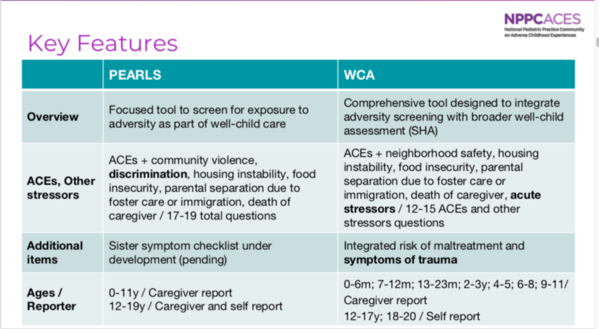Editor’s note: Governor Gavin Newsom set aside federal funds and funds through Proposition 56 that will reimburse health care providers for screening patients in the Medi-Cal program for trauma beginning July 1 using the CPT code 96160. Notably the Department of Health Care Services recommended in March that only California providers using the PEARLS tool to screen pediatric patients will be reimbursed. ACEs Connection has made repeated public records requests for public comments submitted in response to DHCS’s recommendations. See this ACEs Connection story for more details.
Speakers for an April 23 webinar presented an overview of two screening tools recommended by a group of experts in California for screening children for adverse childhood experiences (ACEs). The webinar was organized by the Center for Youth Wellness’ National Pediatric Practice Community on ACEs (NPPC)as California prepares to roll out universal ACEs screening for the 5.3 millionchildren in the state’s Medi-Cal program.
The speakers included: Dr. Jonathan Goldfinger, the chief medical officer of the Center for Youth Wellness (CYW); Dr. Dayna Long, UCSF Benioff Children’s Hospital; Dr. Ariane Marie-Mitchell of Loma Linda University; Sara Marques, the director of strategic initiatives at CWY; Leena Singh, NPPC program director, CYW; and Dr. Neeta Thakur, UCSF School of Medicine.
Several bills have been introduced into the state legislature calling for screening of the state’s children for trauma, but it was only in 2017 that legislation was finally passed, explained Marques. The law, AB340, called for an expert panel to select the most appropriate tools for screening the state’s children for trauma. (Read this article for more background.) Marques was among the members of the expert panel known as the AB 340 workgroup.
The AB 340 workgroup, which was convened by the Department of Health Care Services, included medical, mental health and behavioral health experts, experts in ACEs science, child health advocates and representatives from social service, child welfare and health care agencies.
While the group was tasked with selecting a tool that would screen children for trauma, Marques explained, the group was very clear that prevention had to be part of it. “We needed to cast a wide net for those at risk,” she said.
There was also deep discussion, she said, of what needed to be guiding their decisions if they truly wanted to have impact on moving the needle toward universal screening in the state.
“The core of where we landed was in order to identify a systematic way of identifying children who are experiencing or at risk of experiencing adverse health consequences from exposures to events that were traumatic within the Medi-Cal program and through primary pediatric care, the tool had to be acceptable by the patient or the caregiver, feasible for the provider to use ,and evidence-informed,” said Marques.
And to accomplish their goal, they also recognized that they had to go beyond the 10 original ACE questions in the landmark CDC-Kaiser Permanente Adverse Childhood Experiences Study and include other pressing issues that put children at risk for adverse health outcomes such as community violence and poverty, explained Marques.
After a reviewing the medical literature detailing a number of screening tools that ask about ACEs, the group recommended two tools: the PEARLS (Pediatric ACEs Screening and Resiliency Study) tool, and the Whole Child Assessment (WCA).
While none of the tools in their review had published research distinguishing their validity or reliability, PEARLS and WCA, explained Marques, had been used in California with “very supportive preliminary data.”
PEARLS was developed by the Bay Area Research Consortium on Toxic Stress and Health, which includes the University of California at San Francisco (UCSF), UCSF Benioff Children’s Hospital in Oakland, Calif., and the San Francisco-based Center for Youth Wellness. The WCA was developed by Dr. Ariane Marie-Mitchell and colleagues at Loma Linda University.
Additionally, the AB 340 workgroup recommended a third option of allowing another ACE screening tool to be used if it met the criteria established by the working group.
Significantly, although outside of the scope of the AB 340 workgroup, Marques said that all members were in agreement that if a statewide effort of screening California’s children for ACEs is going to work, there needs to also be in place training for health care providers in how to in use screening tools, and in trauma-informed practices, accessible support services for families, and a way to track the data.
The presenters detailed both of the tools and answered questions posed by participants. Please see the attached document below for the accompanying slides.
NPPC is free to join and the recorded webinar is accessible to all NPPC members in the media library on the NPPC website.


Comments (0)